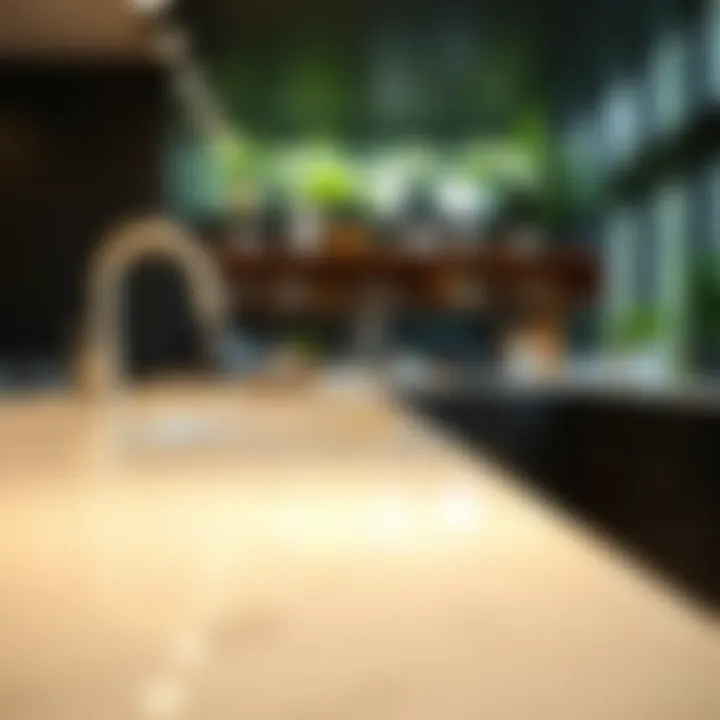Understanding Cleaning and Sanitizing: Key Differences


Intro
In the realm of maintaining a clean and healthy living space, understanding the distinction between cleaning and sanitizing is crucial. Many people often interchange these terms, perhaps underestimating the significant implications each holds for daily life. Cleaning typically refers to the removal of dirt, dust, and impurities from surfaces, while sanitizing goes a step further, aiming to eliminate or significantly reduce pathogens to an acceptable level.
The importance of grasping these differences extends beyond mere vocabulary. As homeowners, design lovers, or health-conscious individuals, we find ourselves in a dance between aesthetics and hygiene. A beautifully designed space can lose its charm if it’s not also a safe environment. Therefore, knowing when to clean versus when to sanitize may very well be the crux of both practical living and indulging in sophisticated decor.
This article aims to illuminate the nuanced processes involved in cleaning and sanitizing, diving deep into the specific practices, recommended chemicals, and scenarios in each one holds sway. By doing so, we provide valuable insights that contribute to building a more informed and health-conscious community.
Prelude to Cleaning and Sanitizing
In a world marked by increasing awareness of hygiene and health, comprehending the nuances between cleaning and sanitizing has never been more critical. Many individuals assume that these terms are interchangeable, but they signify vastly different processes that bear considerable implications for personal and public health. Understanding these differences can empower homeowners, real estate professionals, and design enthusiasts to maintain safe, aesthetically pleasing environments effectively.
Cleaning is about removing dirt, debris, and foreign substances, while sanitizing reduces the number of germs to a safe level. This distinction plays a pivotal role in various contexts ranging from households to commercial spaces. A clean environment not only appears more inviting but also sets the stage for effective sanitization, which is crucial for preventing illness especially in communal settings.
By diving deeper into the processes involved, the tools required, and the specific situations that call for cleaning or sanitizing, readers can make informed choices. This understanding shapes not only personal practices but can influence broader strategies in sectors like healthcare, hospitality, and public safety. The journey through these key differences will unveil best practices and the underlying science, ensuring that both cleaning and sanitizing efforts contribute positively to health and safety.
"Knowing when to clean and when to sanitize can be the difference between a healthy space and one that risks health issues."
Grasping these concepts promises a dual benefit: making workspaces and homes not just clean, but also safe. In the sections that follow, we will lay the groundwork for defining cleaning and sanitizing clearly. Most importantly, we will discuss the reasons why distinguishing between the two is imperative for cultivating environments that prioritize both aesthetics and well-being.
The Process of Cleaning
Understanding the cleaning process is fundamental for fostering not just cleanliness but also hygiene in any environment. The act of cleaning goes beyond merely wiping surfaces; it is an essential practice that helps maintain a healthy and inviting space. A thorough cleaning regimen can reduce allergens, bacteria, and other contaminants that may linger in our surroundings. This section illuminates the tools, techniques, and common pitfalls associated with cleaning, enabling homeowners and design enthusiasts alike to elevate their environments.
Tools and Chemicals Used
First off, let’s talk about the arsenal. Cleaning tools and chemicals vary widely depending on the job at hand. At the very minimum, basic cleaning supplies could include:
- Microfiber cloths: Great for dusting and wiping without scratching surfaces.
- Mops and brooms: Invaluable for floors, offering varying levels of effectiveness depending on material.
- Sponges: Beyond just scrubbing, they can reach into crevices.
Next, you have the cleaners themselves. It's vital to select the right chemical for the surface you are cleaning:
- All-purpose cleaners: These are your jack-of-all-trades, good for most surfaces in the home.
- Disinfectants: Needed for areas that require sanitization post-cleaning, especially in kitchens and bathrooms.
- Green cleaners: For those seeking eco-friendliness, many products have shifted towards safer, natural ingredients that still pack a punch against dirt.
Each tool and product serves a distinct purpose. Knowledge of these can ease the cleaning process, making it not just efficient but also effective.
Step-by-Step Cleaning Procedures
To ensure a thorough clean, it makes sense to follow a structured method. Here’s a breakdown of a step-by-step process that can be adapted to different areas of your home:
- Preparation: Gather all your tools and choose the right cleaning agents.
- Declutter the area: Remove items from surfaces, giving you free range.
- Dusting: Always start from the top (ceiling fans, shelves) and work your way down. This avoids debris falling onto already cleaned areas.
- Clean surfaces: Apply your chosen cleaning solution. Let it sit briefly, especially in the kitchen or on bathroom surfaces, as it often needs time to break down grime.
- Scrubbing: Use sponges or brushes where necessary, especially on stubborn spots.
- Rinse or wipe down: Depending on your cleaning agent, some surfaces should be rinsed with clean water or simply wiped down with a fresh cloth.
- Floor cleaning: Finally, make your way to the floors, utilizing appropriate mops or vacuums.
Following this sequence aids not only in achieving a cleaner environment but also brings about a sense of order in your cleaning endeavors.
Common Mistakes in Cleaning
Even the most careful among us can slip up now and then. Here are some common mistakes to watch out for:
- Using too much cleaner: More isn’t always better. Excess products can leave residue.
- Not reading labels: Different surfaces may require different care. Always check if your cleaner is safe for the materials involved.
- Neglecting tools: Dirty cleaning equipment can do more harm than good, spreading grime rather than removing it.
- Skipping the prep: Rushing into cleaning without decluttering can hinder effectiveness—focus on one area at a time.
"A clean home is a happy home." This adage rings especially true when we are mindful of our cleaning practices. Taking the time to understand the tools and techniques can make a world of difference in the cleanliness and, by extension, the health of our living spaces.


The Process of Sanitizing
Sanitizing plays a critical role in public health and safety, ensuring that spaces remain free from harmful microbes. Unlike cleaning, which primarily focuses on removing dirt and grime, the act of sanitizing specifically targets the reduction of pathogens to levels considered safe by public health standards. This distinction is essential in our everyday environments, from our homes to public areas, especially in light of recent global health crises that have heightened awareness around hygiene.
Sanitizing Agents Explained
To grasp how sanitization works, it's crucial to understand the various agents used. Sanitizing agents can effectively curb the spread of bacteria and viruses. Here are a few common ones:
- Chlorine Compounds: Often used in water treatment, these agents can reduce pathogens efficiently but must be handled with care due to their potency.
- Quaternary Ammonium Compounds (Quats): Found in many household cleaners, these agents are effective against a variety of microorganisms and are favored for their low toxicity.
- Hydrogen Peroxide: This agent has gained popularity for its strong oxidative properties and is effectively used on surfaces in hospitals and homes alike.
These agents each have their own method of action, so it's important to choose the right one based on the specific sanitizing needs of a given area. For example, use quats in kitchens where food is prepared but consider bleach solutions for bathroom disinfection. Understanding the components of these choices helps to optimize outcomes and maintain safety.
Practical Sanitizing Techniques
Sanitizing isn’t just about what you use; it’s also about how you use it. Here are some practical techniques:
- Focus on High-Touch Areas: Prioritize areas that see the most contact, like doorknobs, light switches, and faucets. Using a dedicated sanitizing cloth can help to ensure thorough coverage.
- Follow Contact Time Instructions: Different agents require varied contact times to be effective. For instance, some may need to sit for a minute or two before being wiped away. Without adequate contact time, the sanitizer may not work effectively.
- Use Appropriate Equipment: Using spray bottles, disposable wipes, or electrostatic sprayers can help achieve even distribution of sanitizers on surfaces.
- Personal Protective Equipment (PPE): Always wear gloves and, if necessary, masks while sanitizing to protect yourself from exposure to harsh chemicals.
These practices not only enhance effectiveness but also ensure that sanitizing becomes part of a consistent routine, optimizing the hygiene of your environment.
Regulations and Standards for Sanitization
Safety standards and regulations play a vital role in the process of sanitizing. Numerous guidelines are set by health organizations, such as the US Environmental Protection Agency (EPA) and the Centers for Disease Control and Prevention (CDC). These agencies provide critical resources that define acceptable sanitization practices. Here are a few key points to consider:
- Assess Approved Products: Ensure any sanitizing product is approved for the specific use you intend by checking the EPA registration number. This verifies its efficacy against certain pathogens.
- Adhere to Local and National Regulations: Understanding local health codes, especially for businesses, helps maintain compliance while ensuring the safety of clients and employees.
- Stay Updated with Guidelines: In times of emerging diseases, guidelines can change. It’s important to stay current through reliable sources like the CDC or local health departments.
Incorporating these practices ensures that sanitizing is done effectively and in compliance with health guidelines, safeguarding public well-being.
"The process of sanitizing is not merely a task, but a commitment to health, safety, and well-being for oneself and others."
When to Clean and When to Sanitize
Understanding when to clean and when to sanitize is crucial for maintaining spaces that are not only aesthetically pleasing but also healthy. The distinction between these two processes isn't just about semantics; it has practical implications for public health, environmental integrity, and individual wellbeing. By recognizing the specific contexts that require cleaning or sanitizing, one can ensure greater efficacy in managing germ exposure and potential illness.
Everyday Cleaning Scenarios
Routine cleaning occurs in various settings and is mainly aimed at removing dirt and debris. We can think of everyday activities like washing dishes, wiping down countertops, or dusting furniture. In these scenarios, cleaning typically involves soapy water, detergents, or sprays designed to physically dismantle grime. For example, a kitchen counter gets cleared of crumbs and stains through general cleaning practices.
- Considerations for Everyday Cleaning:
- Frequency: Regular cleaning should happen daily or weekly to keep surfaces fresh.
- Tools: Common tools include:
- Aim: The focus is on appearance and cleanliness rather than germ eradication.
- Microfiber cloths
- Broom and dustpan
- Vacuum cleaners
Situations Requiring Sanitization
Sanitization is especially important in scenarios where germs can pose a significant health risk, particularly in settings such as hospitals, kitchens, and childcare facilities. Here, the goal is to reduce pathogens on surfaces that could lead to illness. For instance, after preparing raw meat, it becomes imperative to sanitize cutting boards and utensils to prevent cross-contamination.
Sanitizing is not just about cleanliness; it is preventive medicine in disguise.
- Examples of Situations Requiring Sanitization:


- Food preparation areas
- Healthcare environments such as clinics and hospitals
- Areas exposed to illness, like schools during flu season
- Shared spaces such as gyms or public transport
Public Spaces and Sanitization Needs
Public spaces such as parks, offices, and shopping centers require specific attention when it comes to sanitization. The communal nature of these places means that they often harbor a multitude of germs from various individuals. Regular cleaning is not sufficient; strategic sanitization efforts must be employed to address potential health hazards effectively.
- Key Factors for Public Space Sanitization:
- High-touch surfaces like door handles, elevator buttons, and public restrooms should be prioritized for sanitizing.
- Compliance with health regulations often dictates the frequency and methods of sanitization employed.
- Consideration of traffic patterns can help guide focused sanitization efforts during peak usage times.
By carefully balancing cleaning and sanitizing efforts based on specific scenarios, one can maximize both the effectiveness of sanitation practices and minimize health risks. Knowing when each practice is necessary not only improves overall hygiene but also contributes to a healthier environment for everyone.
Impact on Health and Safety
Understanding the effect of cleaning and sanitizing on health and safety is not just a matter of preference; it's a crucial part of maintaining any healthy living or working environment. Pollution, allergens, and pathogens are lurking in the nooks and crannies of both residential and commercial spaces, contributing to a host of health complications. When we delve into the interplay between these two processes, we uncover significant implications that can influence everything from personal wellness to the operational safety of public spaces.
Good hygiene practices help in minimizing risks associated with illnesses that could result from contaminated surfaces. The gravity of these implications expands beyond just surface aesthetics; it directly impacts overall community health standards.
Role of Cleaning and Sanitizing in Preventing Illness
The essential function of cleaning and sanitizing lies in their combined ability to prevent the spread of illness. Without proper cleaning to remove dirt and debris, sanitizing agents may struggle to achieve their purpose — killing off harmful germs and bacteria. Think of it as preparing a canvas before painting; no artist would dream of applying color to a surface riddled with imperfections.
Life brings along various pathogens, especially in shared environments such as schools, offices, and healthcare facilities. Implementing strategic cleaning paired with effective sanitizing can significantly reduce the chances of viral outbreaks, common colds, and more serious ailments like flu or respiratory infections. For instance, using products like hydrogen peroxide not only helps sanitize but also doubles up as a cleaning agent by breaking down organic material.
"Prevention is better than cure. Proper cleaning and sanitizing can safeguard not only the individual but also the entire community."
Contamination Risks Associated with Inadequate Practices
Neglecting the importance of distinct cleaning and sanitizing practices can lead to substantial contamination risks. For example, a counter that has been wiped down with a used rag may not truly be clean, as lingering bacteria could multiply and spread. This scenario is particularly alarming in food preparation areas where the cross-contamination of microbes can lead to foodborne illnesses.
Common errors, such as skipping the initial cleaning phase or mismatching cleaning agents with their intended surfaces, can set the stage for a breeding ground of bacteria. Environments lacking proper sanitization can become unwitting hosts to dangerous pathogens, and as demonstrated, not every surface can be assumed safe after a mere wipe-down. As such, ensuring thorough practices safeguards against the pervasive threat of disease transmission.
Specific Vulnerable Populations
Certain groups are more at risk regarding exposure to germs, underscoring the necessity of effective cleaning and sanitizing practices. Infants, the elderly, and those with compromised immune systems are particularly susceptible. Hospital environments highlight this vulnerability; a sterile space is a basic requirement, as infections can spread effortlessly amongst patients with fragile health.
Similarly, within domestic settings, homes with young children should adopt rigorous sanitizing routines. Children are often more prone to picking up infections due to their developing immune systems and tendency to explore their surroundings, likely leading to increased contact with potentially contaminated surfaces.
Addressing these vulnerabilities is vital to creating a health-conscious culture, both at home and in larger community contexts. By incorporating systematic cleaning and sanitizing practices, we can actively contribute to protecting those who may be more easily affected by illness.
Maintaining a robust approach to cleaning and sanitizing ultimately protects not just individuals but collective community health, setting a standard for safety that resonates across various sectors. For more information on health impacts related to sanitation, visit Health.gov and Centers for Disease Control and Prevention.
Environmental Considerations
In recent times, the significance of environmental considerations in the realm of cleaning and sanitizing cannot be overstated. As more individuals become aware of their ecological footprint, there's an emerging demand for practices that not only ensure cleanliness and health but also minimize harm to the planet. When discussing the processes of cleaning and sanitizing, it's crucial to understand how choices in products and methods impact the environment, keeping in mind both immediate results and long-term effects on ecosystems.
Eco-friendly Cleaning Products
When choosing cleaning products, opting for those labeled as eco-friendly can make a significant difference. These products typically utilize natural ingredients, which lessen the amount of harmful chemicals released into the air and water systems. For instance, ingredients like vinegar, baking soda, and essential oils are often both effective and safe for the environment.
The benefit of using eco-friendly products is twofold: not only do they clean effectively, but they also protect delicate ecosystems. Many traditional cleaners have toxic elements that can harm aquatic life once they flow into waterways. By switching to eco-conscious alternatives, individuals contribute to preserving biodiversity while maintaining a clean environment.


Sustainability in Sanitization Practices
Sustainability extends beyond mere product choice; it encompasses entire practices as well. Implementing sanitization measures that are sustainable means prioritizing methods that maintain health standards without compromising environmental integrity. For instance, using microfiber cloths for cleaning not only reduces chemical reliance but also lessens waste production drastically. This approach is often seen in professional cleaning services aiming to lower their carbon footprint.
Moreover, some sanitizing agents, like hydrogen peroxide or vinegar, are praised for their effectiveness, but when used with an awareness of their environmental impact, they can achieve excellent results. Recognizing the broader implications of sanitizing processes allows us to align health and safety goals with environmental stewardship.
Balancing Effectiveness and Environmental Impact
Striking a balance between effectiveness in cleaning and sanitizing and ensuring minimal environmental harm is the crux of modern cleaning practices. It requires diligence in evaluating both new technologies and old methods. For instance, disinfectants that boast rapid action against germs often come with a cocktail of harsh chemicals. However, many green products now offer comparable results without the pollutive side effects.
Adopting a comprehensive approach involves:
- Assessing individual cleaning needs and the associated sustainability of chosen products.
- Educating oneself and staff on the lingering effects of conventional cleaning agents on health and the environment.
- Staying updated on regulations or certifications of cleaning products, ensuring adherence to eco-friendly standards.
Understanding the dual aspects of effective cleaning while placing a strong emphasis on preserving the environment is crucial for conscientious homeowners and professionals alike. A well-rounded approach paves the way for a cleaner, healthier planet, while still upholding standards of hygiene and safety.
Economic Implications of Cleaning and Sanitizing
When we consider cleaning and sanitizing, the conversation often drifts toward hygiene and health. However, it's equally crucial to discuss the economic implications of these practices. Getting a grip on how cleaning and sanitizing affect finances can greatly influence decisions in both residential and commercial spaces. Knowing the potential savings, costs, and even financial risks tied to inadequate cleaning or sanitizing can put you on the path to smarter practices.
Costs Associated with Cleaning vs. Sanitizing
At the first glance, it may seem like cleaning and sanitizing are similar, often culminating in untold costs for homeowners. However, looking deeper can unearth significant differences in their financial impact.
- Cleaning Costs: The expenses associated with cleaning often include everyday supplies like brooms, mops, detergents, and labor or service fees. While these costs can add up, they are generally lower than sanitizing.
- Sanitizing Costs: On the other hand, costs for sanitizing are typically higher. Sanitizing products often contain specialized chemicals that may be more expensive than traditional cleaning agents. In addition, labor costs for sanitizing can be higher due to the stringent processes that may be required to ensure effectiveness.
- Frequency of Maintenance: Depending on the environment, the frequency of these processes can vastly differ in terms of cost. For instance, a restaurant may require regular sanitization, whereas a home might only need occasional sanitized cleanings. This distinction can affect long-term budgeting and resource planning.
Long-term Financial Benefits of Proper Practices
Investing time and resources into effective cleaning and sanitizing practices can yield long-term financial benefits that often outweigh the initial expenditure. By understanding these aspects, property owners can exploit potential savings and improve the longevity of their investments.
- Reduced Health Risks: Proper cleaning and sanitizing can prevent illness outbreaks, minimizing healthcare costs and employee absenteeism. Investing in these practices now can save significant money in medical expenses down the road.
- Asset Preservation: Maintaining an environment that is regularly cleaned and sanitized isn't just about hygiene. It's also about preserving properties and materials. For example, regular cleaning of carpets and upholstery can extend their lifespan and reduce the need for costly replacements.
- Customer Loyalty: For businesses, maintaining a clean and sanitized space can enhance customer satisfaction, leading to repeat business. Satisfied customers often result in higher revenue in the long run.
"Budgeting for cleaning and sanitizing today can save a bundle tomorrow."
For more information on effective cleaning practices and their impacts, you might want to check these resources: CDC - Cleaning a Room, EPA - Safe Choice.
Epilogue: Balancing Both Practices for Optimal Outcomes
In navigating the realm of cleaning and sanitizing, finding the right balance between the two is paramount. Each practice serves a distinct purpose, yet together they form a comprehensive approach to maintaining hygiene and safety. Recognizing that cleaning removes dirt and impurities while sanitizing tackles germs helps individuals and organizations alike create spaces that are not only visually appealing but also health-conscious.
Integrating Cleaning and Sanitizing into Daily Routines
To effectively blend both practices into daily life, one must first analyze the environments in which they operate. For instance, in a home, it’s beneficial to establish a cleaning schedule that differentiates between areas that require frequent cleaning and those needing less regular sanitization. For example:
- Kitchen and bathrooms should prioritize sanitizing due to their high germ exposure.
- Living areas and bedrooms can focus more on regular cleaning to maintain aesthetics.
By implementing a routine that incorporates both cleaning and sanitization in a strategic manner, households can improve their overall health and safety. People may consider setting specific days for deep cleaning tasks while ensuring that sanitizing wipes or sprays are readily available for daily use. Additionally, being mindful of which cleaning products do double duty can reduce effort and enhance efficiency.
Future Trends in Cleaning and Sanitizing
As technology evolves, so too will the methodologies surrounding cleaning and sanitizing. There are emerging trends that promise to revolutionize the way we think about hygiene. For instance, the use of smart cleaning systems, which enable automated cleaning tasks through apps and voice assistance, is becoming more accessible. In the realm of sanitization, advancements in ultraviolet light and other physical sanitizing techniques offer new approaches to disinfecting surfaces without relying solely on chemical agents.
Moreover, the push for environmentally-friendly cleaning solutions is gaining momentum. Consumers are increasingly aware of the environmental impacts of harsh chemicals, leading to a surge in demand for natural and biodegradable products. It's essential to stay updated on these trends, as adopting innovative practices can greatly enhance efficacy in maintaining cleanliness while being gentle on the earth.
The interplay between cleaning and sanitizing is clear. By understanding when and how to effectively integrate both into our lives, we not only promote a safer environment but also pave the way for a more sustainable future in hygiene practices.
"Cleaning is about removing the clutter, but sanitizing ensures that your space is truly safe. Combining both allows for a cleaner, healthier life."
By striking a balance, one takes a step towards creating not only a hygienic space but also a sanctuary that fosters well-being and comfort.



